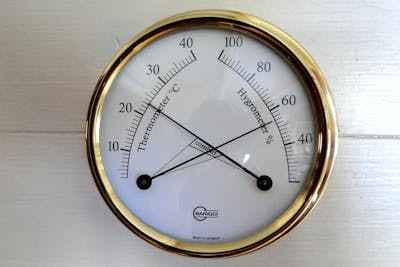Maintaining the right humidity level in your home during the winter months is crucial for comfort, health, and home maintenance. When the air is too dry, it can lead to respiratory problems, static electricity, damage to your home interior, and general discomfort. Conversely, too much humidity can cause other problems like condensation, dust mites, pest infestation, etc. This article, therefore, explores the ideal and best humidity level for home in winter, and tips to maintain them.
Understanding Humidity
Humidity is the measure of water vapor in the air. Temperature, geographic location, and seasonal changes influence humidity levels. Warm air holds more moisture, so humidity is higher in summer and lowers in winter.
Areas near water bodies or in tropical climates have higher humidity due to more evaporation and precipitation, while arid regions and higher altitudes have lower humidity. Seasonal transitions also cause fluctuations, with moderate humidity in spring and fall compared to the extremes of summer and winter. Humidity levels have an impact on the condition of both our health and our homes.
Best Humidity Level for Home in Winter.
The ideal humidity level for winter, according to the Environmental Protection Agency (EPA), is between 30% and 50%. Maintaining this level in your home during the winter helps prevent the issues associated with both high and low humidity, keeping you comfortable and healthy as well as preserving your home.
What Happens when the Humidity Level is very Low?
When the humidity is too low in winter, it can dry up the nasal passages of the throat and nose, which facilitates the entry of germs and viruses into the body. It causes moisture to evaporate from the skin’s surface, damaging the skin barrier, and it can also cause the tear film that protects the eyes to evaporate quickly in dry air. Additionally, it dries out and shrinks wood; all these factors then lead to the following issues:
- Respiratory disorders such as colds and flu
- Dryness and discomfort in the eyes
- Eye irritation and dryness
- Cracking and warping of wooden furniture
- Paint may also peel or break as a result of it.
When the humidity is too high in winter
On the contrary, when humidity is too high, it can cause various issues due to the excess moisture in the air, resulting in several problems such:

- Condensation on windows, leading to water damage
- Mold and mildew growth on frames, sills, and walls.
- Dust mites thrive in moist environments caused by high humidity
- The moist environments attract pests like cockroaches, termites, and rodents
- Musty odors as a result of the mold and mildew growth
- The air feels warmer and more unpleasant
High humidity in the winter can also cause respiratory problems like coughing, congestion, and asthma attacks. This is because mold spores and dust mites, which thrive in humid environments, trigger allergic reactions in many people.
It is therefore important to maintain the ideal indoor moisture content to prevent these issues and enhance the comfort of your living space.
Tips to Maintain Ideal Humidity Level in Winter
Below are some tips for maintaining ideal humidity levels in your home during the winter:

1. The use of a humidifier: A humidifier is an efficient and effective way to increase humidity levels in your home during the winter. It works by releasing moisture into the air. This added moisture helps to maintain a comfortable indoor environment.
2. Houseplants: Houseplants, such as ferns and peace lilies, are a natural and eco-friendly way to increase humidity in your home during the winter. These plants act as natural humidifiers, helping to raise humidity levels naturally.
Insulate Your Home: Proper insulation in walls, attics, and basements helps maintain a stable indoor environment, reduces humidity fluctuations, and maintains the right moisture level in your home during the winter. You may also want to use double-glazed or storm windows to improve insulation and reduce condensation.
3. Seal Windows and Doors: Weatherstripping around windows and doors to prevent drafts and keep proper moisture levels indoors.
4. Regular Monitoring and Adjustment: Humidity levels should be checked regularly during the winter, at least once a week. This frequent monitoring allows you to adjust humidifiers or dehumidifiers accordingly to keep the indoor environment within the optimal humidity range.
How to Measure Indoor Humidity

Use a hygrometer to measure the humidity levels in your home. This device is specifically designed to measure humidity. There are analog and digital hygrometers. I advise you to go for a digital humidity gauge because they are usually the most accurate and easy to read, with the ability to measure temperature alongside humidity. To use it, follow the steps below:
Step 1: Install the Battery
Insert the batter at the space provided at the back, it usually comes with 1 AAA battery. Most digital hygrometers usually turn on as soon as the battery is inserted, while some models might have a power button that you need to press to turn them on, but this is less common.
Once the humidity gauge is powered on, it will usually take about 5 minutes to adjust to the current humidity level, known as calibration. During this time, the display might show inaccurate readings, so it’s important to wait until the calibration process is complete before using the device.
Step 2: Placement
Place the hygrometer in the room where you want to measure humidity, away from direct sunlight, heaters, air vents, or any source of moisture. You can set it reasonably squarely or hang it on a wall using the wall hanger slot. or use the rectangular stand. Once placed, wait for another five minutes before checking the result for accuracy.
Step 3: Read the Measurement
Check the digital screen. Some models also display the temperature at the top of the screen, with a line drawn across the screen separating the temperature above and the humidity level below, which is usually displayed as a percentage (%).
There are several other ways to measure indoor humidity levels, such as moisture-sensitive papers like Humidity Indicator Cards (HIC) and Humidtect, which change color based on the humidity level, and humidity sensors among others.
Conclusion
Maintaining the ideal indoor humidity level during the winter is essential for your health, and comfort, and for preserving your home’s condition. By using humidifiers and implementing the tips to keep the right humidity levels in winter, you can keep the recommended range of 30% to 50% and ensure a comfortable and healthy indoor environment throughout the winter months.
Frequently Asked Questions (FAQs)
How can I reduce the humidity ratio, if too high?
To decrease humidity, use a dehumidifier, ensure proper ventilation, and use exhaust fans in the kitchen and bathroom. You may also want to open windows occasionally to help balance indoor humidity levels.
How often should I check humidity levels in winter?
It is recommended to check indoor humidity levels at least once a week during the winter months to ensure they are within the ideal range.
How can I know if my home has high or low humidity in winter?
To determine winter indoor air quality, use a hygrometer, a thermostat with a humidity sensor, or moisture-sensitive paper to monitor the humidity. Additionally, the presence of high humidity can lead to physical signs like mold growth, wood rot, increased dust mite activity, musty odors, and condensation on your windows may also be noticed.
What are some common mistakes to avoid when trying to control indoor humidity?
When controlling indoor humidity, common mistakes to avoid include over-humidifying, neglecting to use a hygrometer, and failing to maintain HVAC systems, humidifiers, and dehumidifiers regularly or placing them in inappropriate locations. Blocking ventilation, not addressing sources of excess moisture, and using tap water in humidifiers can all lead to improper humidity level at home.
What Is the Best Indoor Relative Humidity in Winter?
The appropriate humidity level in winter is between 30% and 50%. This range protects furniture and prevents dryness. If the humidity level is too low, use a furnace humidifier to maintain stability.










